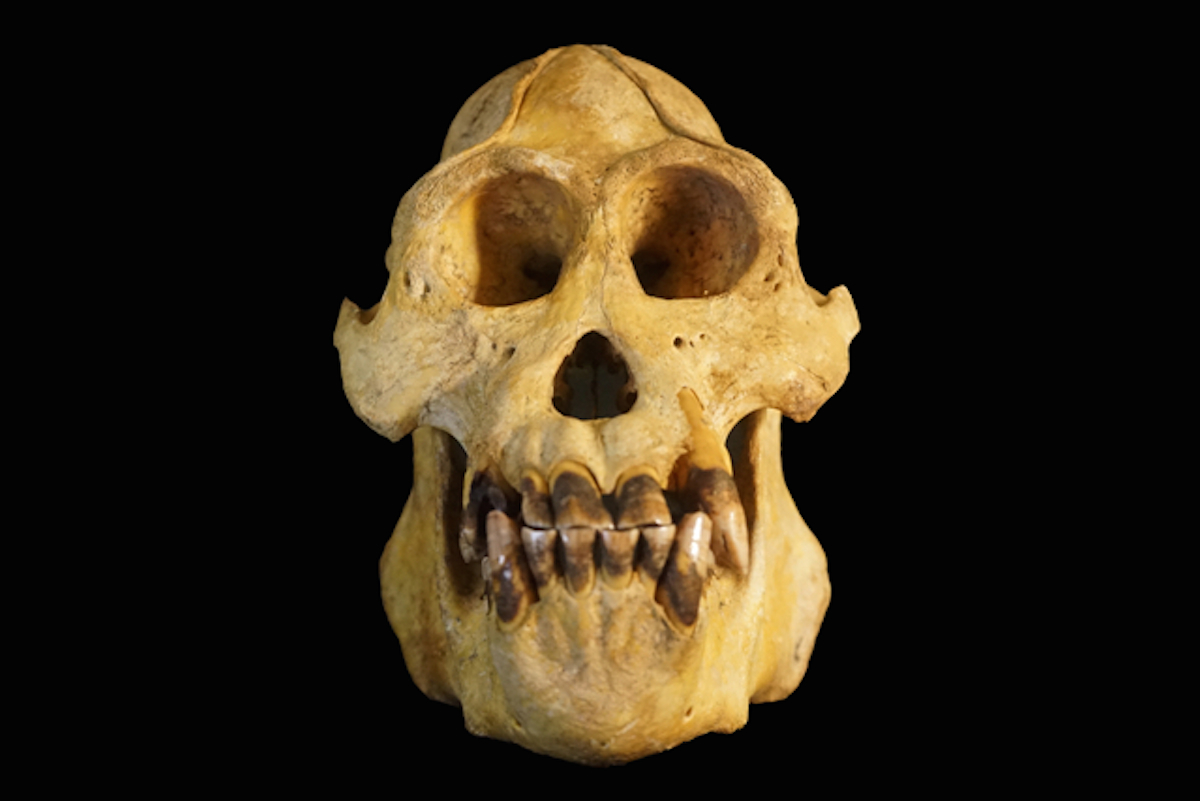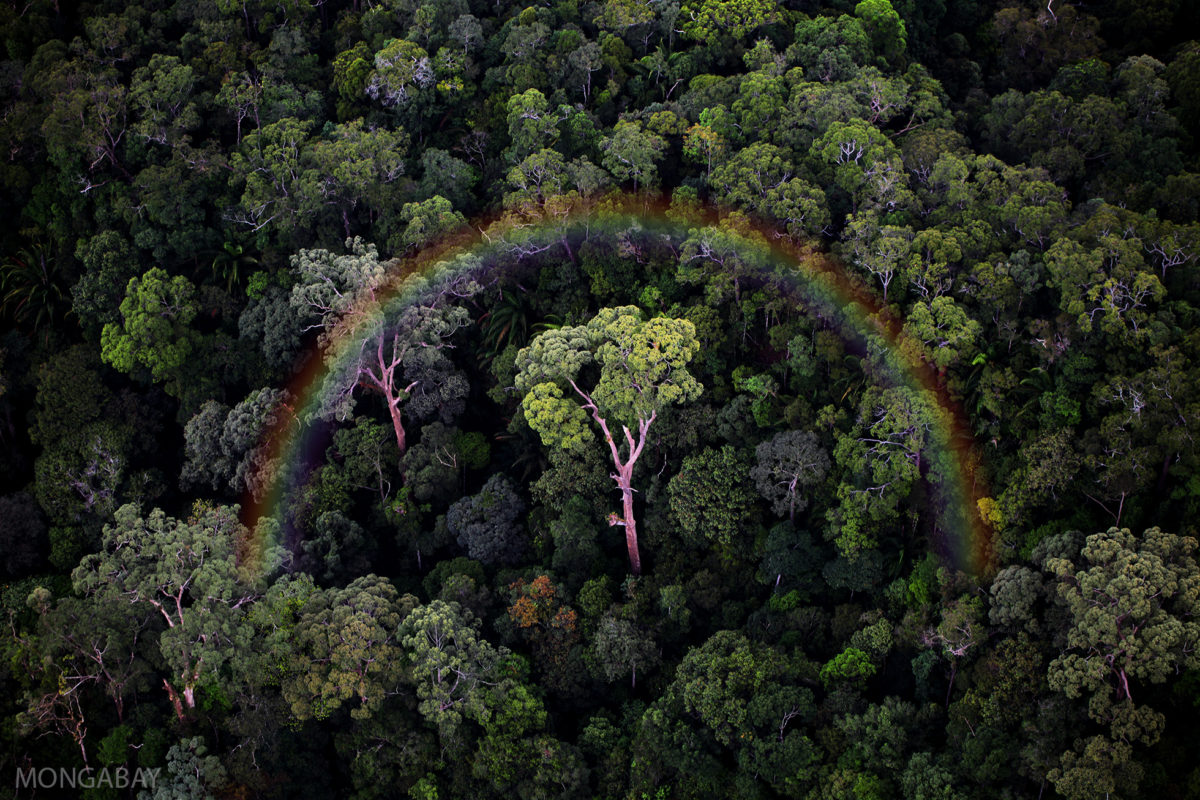- A study indicates what was once assumed to be an isolated population of the Sumatran orangutan is in fact a distinct species.
- The Batang Toru orangutan differs from the Sumatran orangutan in morphology, behavior and genetics. Genomic analysis suggests it diverged from other orangutan species 3.4 million years ago.
- There are fewer than 800 Batang Toru orangutans in existence, making it the rarest of all the great apes.
- It is highly threatened by habitat loss. The study says a hydropower plant planned for the area could affect 8 percent of the species’ remaining forest habitat.
Yesterday, there were seven recognized great ape species in the world. Today there is an eighth, with the release of a study describing a new species of orangutan in Sumatra, Indonesia. And this species is quite distinct — the study finds big differences in how it looks, how it acts and when it separated evolutionarily from other orangutans.
It also may be the most endangered great ape on the planet.
It’s being called the Batang Toru (also Tapanuli) orangutan (Pongo tapanuliensis), and was once considered simply an isolated southern population of the Sumatran orangutan (P. abelii). But a study conducted by some three dozen researchers and published today in the journal Cell Press tells a different story.


Researchers first suspected this population might be different back in 2011, after initial genetic studies indicated Batang Toru orangutans could be more closely related to Bornean orangutans than to other Sumatran orangutans.
“We realized then that something unusual was going on,” said Erik Meijaard, a conservation scientist with a background in anthropology and biology, and an author of the study.
So Meijaard and his colleagues set to work comparing orangutans from the Batang Toru population to both Sumatran and Bornean (P. pygmaeus) orangutans. They looked at the behavior of the different populations, as well as comparing the skull of a Batang Toru male to 33 other male orangutans of a similar age. They also analyzed 37 orangutan genomes to figure out when the populations diverged in evolutionary time.
Big differences
They discovered that the Batang Toru skull was notably different than the others. It had broader canines, a shallower face and a narrower jawline than both Sumatran and Bornean orangutans, among many other differences detailed in the study. However, the team only had one skull to work with, from an individual killed in a conflict with humans in 2013, so they cannot be absolutely sure these differences typify the population and aren’t just unique to their sample skull.


“We cannot be confident,” Meijaard told Mongabay. “But neither could we be confident with 10 specimens. That is the nature of science. Given that getting a lot more specimens in the near future is highly unlikely for such a rare species (and also unwanted as we don’t want animals dead), we have to work with what we have.”
But, Meijaard stressed, the differences in the Batang Toru skull “are real and likely fundamental to functional morphology. They are not just an overall size difference.”
Batang Toru orangutans are physically different in other ways, too. They have frizzier hair than their northern counterparts, and a “prominent moustache” is present on dominant males, according to the researchers. Females have beards, unlike Bornean orangutans.
Batang Toru orangutans are also behaviorally different than other populations. The researchers write that Batang Toru males have calls that sound higher in pitch than Sumatran males. Meijaard said that they also observed differences in feeding behavior, with the new species choosing to eat plants “no other orangutans have ever been seen eating.” He added that Sumatran, Bornean and Batang Toru orangutans also all seem to build different styles of nests. However, he added these latter two behaviors are not yet well understood, so were not included in the study.
The biggest surprise came when the team analyzed the DNA of 37 orangutans. Unlike the genetic analyses in 2011 that looked at just mitochondrial DNA, which is comparatively small and inherited only through the maternal line, Meijaard and his colleagues considered the entire set of genetic information, or genome, of 37 orangutans.

They found distinct differences between the genomes of Sumatran, Bornean and Batang Toru populations. Batang Toru DNA was so distinct, in fact, that it appears they split off as a species even before Bornean and Sumatran orangutans diverged. In fact, the study indicates Batang Toru orangutans are less closely related to Sumatran orangutans than they are to those on Borneo — a whole other land mass more than 1,000 kilometers (620 miles) away.
What’s more, the researchers found the Batang Toru divergence happened a very, very long time ago — about 3.4 million years.
“That was indeed highly surprising because that split is very old and it occurred between two taxa that are only a few hundred [kilometers] away from each other,” Meijaard said.
They were close enough that interbreeding between Batang Toru and Sumatran still likely happened. The study’s results indicate some gene flow did occur between the species, before slowing around 100,000 years ago and stopping altogether sometime between 10,000 and 20,000 years ago. The researchers write that this coincides with the eruption of the Toba supervolcano 73,000 years ago, one of the world’s biggest-known volcanic eruptions that destroyed habitat between the two populations.
An uncertain future
Habitat destruction is still a big concern for orangutans. This time it’s not from the eruption of a volcano, but from the expansion of human development. Previous research indicates Sumatran orangutans lost 60 percent of their key habitat between 1985 and 2007, and roads, industrial agriculture plantations, mines and dams continue to whittle away their remaining forests. Poaching is also a major problem, with orangutans often killed so their babies can be sold in the illegal pet trade, or exterminated for raiding crops.
The IUCN currently lists Sumatran orangutans as Critically Endangered, with a 2016 census estimating around 14,000 individuals exist on the island. Of these, researchers think fewer than 800 belong to the Batang Toru population, making it the world’s rarest great ape species. They all live in a patch of degrading primary forest surrounded and bisected by major roads, with secondary roads pressing ever inward.

Data from the forest monitoring platform Global Forest Watch show their range lost about 2,000 hectares of primary forest over 10 years from 2005 to 2014, and less than 6 percent is currently federally protected. A large logging concession occupies much of the western extent of the Batang Toru’s range.
A big, new threat has arisen in the past few years: the construction of a 510-megawatt hydroelectric plant. Said to be the largest hydropower project on Sumatra, the plant and its dam are part of a nationwide effort to step up energy generation in the face of an expected 9 percent increase in electricity demand per year. The plant, projected to be operational in 2022, is destined for 645 hectares of land along a major river — in an area with the highest known Batang Toru orangutan density.
The researchers say that if the project goes through to completion, it stands to affect 8 percent of the orangutans’ habitat. It’s also been criticized for threatening to evict indigenous communities from their ancestral territories, and damaging the habitat of other threatened species.
“This project … would jeopardize chances of maintaining habitat corridors between the western and eastern range, as well as smaller nature reserves, all of which maintain small populations of P. tapanuliensis,” the researchers write.
They add that the species’ small population size and isolation has already led to inbreeding, which stands to worsen unless conservation measures are “implemented swiftly”.
Citations:
- Nater et al., Morphometric, Behavioral, and Genomic Evidence for a New Orangutan Species, Current Biology (2017), https://doi.org/10.1016/j.cub.2017.09.047
- IUCN and UNEP-WCMC (), The World Database on Protected Areas (WDPA) [On-line], September, , Cambridge, UK: UNEP-WCMC. Available at: www.protectedplanet.net. Accessed through Global Forest Watch in October, 2017. www.globalforestwatch.org
- Hansen, M. C., P. V. Potapov, R. Moore, M. Hancher, S. A. Turubanova, A. Tyukavina, D. Thau, S. V. Stehman, S. J. Goetz, T. R. Loveland, A. Kommareddy, A. Egorov, L. Chini, C. O. Justice, and J. R. G. Townshend. 2013. “High-Resolution Global Maps of 21st-Century Forest Cover Change.” Science 342 (15 November): 850–53. Data available on-line from:http://earthenginepartners.appspot.com/science-2013-global-forest. Accessed through Global Forest Watch on October 31, 2017. www.globalforestwatch.org
- Margono, B.A., P.V. Potapov, S. Turubanova, F. Stolle, and M.C. Hansen. “Indonesia primary forest.” Accessed through Global Forest Watch on October 31, 2017. www.globalforestwatch.org
- Banner image by Maxime Aliaga.
FEEDBACK: Use this form to send a message to the editor of this post. If you want to post a public comment, you can do that at the bottom of the page.


